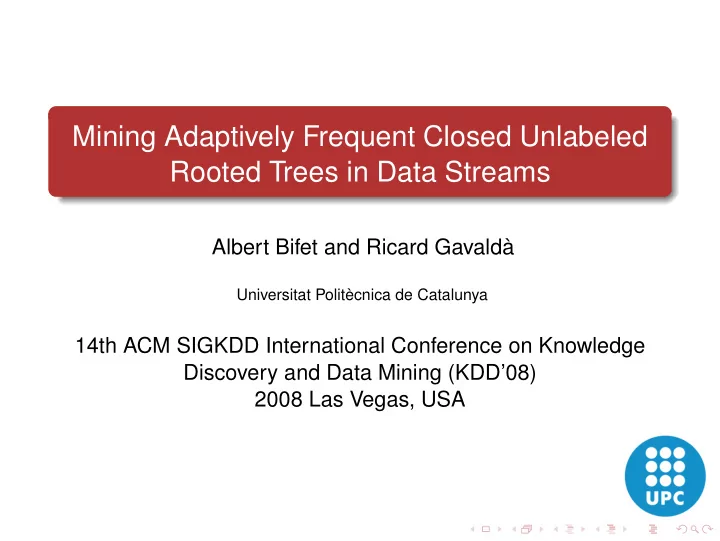

Mining Adaptively Frequent Closed Unlabeled Rooted Trees in Data Streams Albert Bifet and Ricard Gavaldà Universitat Politècnica de Catalunya 14th ACM SIGKDD International Conference on Knowledge Discovery and Data Mining (KDD’08) 2008 Las Vegas, USA
Tree Mining Mining frequent trees is becoming an important task Applications: chemical informatics computer vision text retrieval bioinformatics Data Streams Web analysis. Sequence is potentially Many link-based infinite structures may be High amount of data: studied formally by sublinear space means of unordered High speed of arrival: trees sublinear time per example
Introduction: Trees Our trees are: Our subtrees are: Rooted Induced Unlabeled Ordered and Unordered Two different ordered trees but the same unordered tree
Introduction What Is Tree Pattern Mining? Given a dataset of trees, find the complete set of frequent subtrees Frequent Tree Pattern (FS): Include all the trees whose support is no less than min_sup Closed Frequent Tree Pattern (CS): Include no tree which has a super-tree with the same support CS ⊆ FS Closed Frequent Tree Mining provides a compact representation of frequent trees without loss of information
Introduction Unordered Subtree Mining A: B: X: X: Y: Y: D = { A , B } , min _ sup = 2 # Closed Subtrees : 2 # Frequent Subtrees: 9 Closed Subtrees: X, Y Frequent Subtrees:
Introduction Problem Given a data stream D of rooted, unlabelled and unordered trees, find frequent closed trees. We provide three algorithms, of increasing power Incremental Sliding Window Adaptive D
Relaxed Support Guojie Song, Dongqing Yang, Bin Cui, Baihua Zheng, Yunfeng Liu and Kunqing Xie. CLAIM: An Efficient Method for Relaxed Frequent Closed Itemsets Mining over Stream Data Linear Relaxed Interval :The support space of all subpatterns can be divided into n = ⌈ 1 / ε r ⌉ intervals, where ε r is a user-specified relaxed factor, and each interval can be denoted by I i = [ l i , u i ) , where l i = ( n − i ) ∗ ε r ≥ 0, u i = ( n − i + 1 ) ∗ ε r ≤ 1 and i ≤ n . Linear Relaxed closed subpattern t : if and only if there exists no proper superpattern t ′ of t such that their suports belong to the same interval I i .
Relaxed Support As the number of closed frequent patterns is not linear with respect support, we introduce a new relaxed support: Logarithmic Relaxed Interval :The support space of all subpatterns can be divided into n = ⌈ 1 / ε r ⌉ intervals, where ε r is a user-specified relaxed factor, and each interval can be denoted by I i = [ l i , u i ) , where l i = ⌈ c i ⌉ , u i = ⌈ c i + 1 − 1 ⌉ and i ≤ n . Logarithmic Relaxed closed subpattern t : if and only if there exists no proper superpattern t ′ of t such that their suports belong to the same interval I i .
Galois Lattice of closed set of trees 2 1 3 D We need 12 23 13 a Galois connection pair a closure operator 123
Algorithms Algorithms Incremental: I NC T REE N AT Sliding Window: W IN T REE N AT Adaptive: A DA T REE N AT Uses ADWIN to monitor change ADWIN An adaptive sliding window whose size is recomputed online according to the rate of change observed. ADWIN has rigorous guarantees (theorems) On ratio of false positives and negatives On the relation of the size of the current window and change rates
Experimental Validation: TN1 CMTreeMiner 300 Time 200 (sec.) 100 I NC T REE N AT 2 4 6 8 Size (Milions) Figure: Time on experiments on ordered trees on TN1 dataset
Experimental Validation 45 35 Number of Closed Trees 25 AdaTreeInc 1 AdaTreeInc 2 15 5 0 21.460 42.920 64.380 85.840 107.300 128.760 150.220 171.680 193.140 Number of Samples Figure: Number of closed trees maintaining the same number of closed datasets on input data
Summary Conclusions New logarithmic relaxed closed support Using Galois Latice Theory, we present methods for mining closed trees Incremental: I NC T REE N AT Sliding Window: W IN T REE N AT Adaptive: A DA T REE N AT using ADWIN to monitor change Future Work Labeled Trees and XML data.
Recommend
More recommend